Welcome to the Washington University Law School’s Rare Book Room housed on the first floor of the Law Library located in Anheuser-Busch Hall. The collection contains over 1850 titles and is particularly strong in 15th and 16th English imprints, imprints of legal titles from the early American Republic as well as works dealing with Canon law and practice. The mission of the Law Library is to preserve these historical materials and make them available for use by scholars and students. A select few of our titles are listed below.
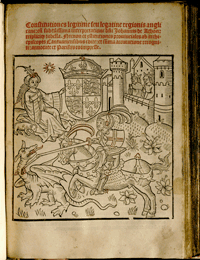
Constitutiones legitime sue legatine
regionis anglicane. Woodcut of
St. George and the Dragon on the
Title Page. Paris, 1504.
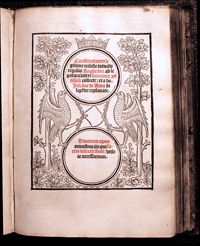
Constitutiones legitime sue legatine
regionis anglicane. Woodcut of two
hawks on the Half-title. Paris, 1504.
INDIVIDUAL TREASURES
Individual legal and historical treasures housed in the Rare Book Room include:
- 1531 printing by Thomas Berthelet of the Magna Carta;
- first editions of both the British and American editions of Blackstone’s Commentaries on the Laws of England;
- the first edition of the first English translation of Montesquieu’s Spirit of the Law;
- Coke’s The Institutes of the Laws of England, including first editions of volumes 2, 3, and 4 and the second edition of volume 1;
- first edition of Thomas Hobbes’ Leviathan published in 1651;
- third edition of John Locke’s Two Treatises of Government, printed in London, 1698, and first printed in 1690; and
- the first edition of the Code Napoleon published in Paris in 1808.
COLLECTIONS
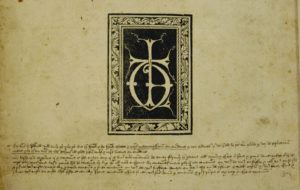 Statham’s Abridgment. William Tailleur’s
Statham’s Abridgment. William Tailleur’s
mark on books printed by him for
Richard Pynson at Rouen about 1489.
Incunabula
The Rare Book Collection contains four books printed prior to 1501. Two are:
- Statham’s Abridgement, printed by Richard Pynson in the late 1400’s; and
- Laws of Genoa, Statuta et Decreta Communis Genuae: Quae Quam Ordinatissime Diligentissime et Castigatissime ad Communem Cunctorum Genuensium Utilitantem nec non Voluptatem Impressa Sint Liquido Patebit Legentibus, edited by Antonio Maria Visdomini and published in 1498 in Bologna by Caligola de’ Bazalieri. This is the only edition and is in Latin.
Pre-1600 English Printings
The Rare Book Collection is particularly strong in pre-1600 publications. Many of these early volumes are valued for the handwritten annotations in the margins, woodcuts and printers’ marks. Together with the Magna Carta, mentioned above, other titles dating back to the 1500’s include English statutes and case books called Year Books. The collection numbers around 100 titles, many published in Law French or in Latin.
- Les Plees del Coron: Devisees in Plusiours Titles & Common Lieux by Sir William Staunford. Published in London in 1567, this quarto is a third edition, the original published in 1557, and is considered a principal book by Pollock and Maitland which allows the researcher to trace modern laws of crimes from the later Middle Ages onwards. This treatise by Staunford, based on Bracton and the Year Books, is divided into three parts: offences; jurisdiction, including appeals, indictments and defenses; and finally trials and convictions. Staunford wrote his treatise after being appointed judge of the common pleas in 1554.
- Liber Assisarum et Placitorum Corone or the Book of Assizes, printed by John Rastell in London in 1514. This title is a rare, first edition of the first law book printed by Rastell and the fifth law book published in England. A selection of reports 1 through 50 Edward III (1327-1377), the Book of Assizes or Liber Assisarum is one of the most important of the Year Books and of unique value to the study of English legal history. This collection of reports from the justices on assize, the circuit courts, was published by John Rastell, the brother-in-law of Sir Thomas More.
- Abridgement of the booke of Assises, lately perused over, and corrected, & nowe newely imprinted by Richard Tottill the last day of September Anno do. 1555. Published in 1565 by Richard Tottell in London, this second abridgment of the Year Books is one of four (with Brooke, Fitzherbert and Statham) essential to the study of medieval English law.
- Intrationum Liber Omnibus Legum Anglie Studiosis Apprime Necessarius or the Book of Legal Writs, printed in London in 1510. This is a rare first edition and contains pleadings in real, personal and mixed actions, information on writs and executions and miscellaneous information on other topics. The anonymous author derived his material from the plea rolls, a fundamental source for early English legal history. (The collection also contains a 1546 imprint which has 17 additional pages of precedents in a fine contemporary chancery hand.)
- De termino Hillarii/Anno regni Regis Edwardi tertii post conquestum vicesimo secundo [through De termino sancti Michaelis anno regni region Edwardi tertii xxviii]. Printed by Berthelet in 1532 in London, these are the first editions of all the Year Book reports printed here, and first printings of all the years except Year 24 (which was first printed by Redman from another manuscript in 1528) during the reign of Edward III in the mid-14th century.
- Le Court Leete, Et Court Baron, Collect per John Kitchyn de Grays…[And] Retourna Brevium Novelment Corrigee… by John Kitchin, c.1520-c.1590. This is an enlarged edition by Kitchin who, along with Coke, helped lay the foundation of modern legal theory. Only two other copies of this imprint in North America.
- Herein is Conteined the Booke Called Novae Narrationes…attributed to Anthony Fitzherbert (1470-1538) and published in London by Richard Tottel, 1561. In Law French (first & third parts) and Latin (second part). This is a third edition. A work of considerable authority during the reign of Henry VI, it is the first work to discuss the jurisdiction of courts and was first printed by Pynson around 1515. The continuous foliation is in three parts: (1) has precedents of pleading upon a number of writs, some with annotations; (2) describes different types of pleas and says a few words about the different courts; and (3) dates from the reign of Henry VIII and describes the different courts and their jurisdictions.
- La Nouvelle Natural Breviu[m] du Judge Tresreuerende Monsieur Anthony Fitzherbert, Denierement Renue & Corrige per Laucteur, Avecques un Table Perfecte des Choses Notables Contenus en Ycell, Novelment Compose per Guiliaulme Rastell, & Iammais per Cydeuaunt Imprimee. Printed by Richard Tottell in London in 1576. First published in 1534, the Nouvelle Natural Brevium is a manual of procedure written by a Judge of the Common Pleas during the reign of Henry VIII. This book contains several original observations on the form and function of writs and also contains Rastell’s revisions, including the addition of a table. Nearly half of this volume is a manuscript and has copious annotations ranging from lists of cases and cross-references to reporters and abridgments in the margins to extensive commentaries and analytical glosses in the interleaves.
- The Contentes of this Booke…published by Richard Tottell of London, 1574. This is a first edition. An anthology of treatises for justices of the peace, sheriffs, bailiffs, this book includes the Carta Foedi and exchequer ordinances and is sometimes erroneously attributed to Anthony Fitzherbert. Only seven copies of this edition exist. (The collection also contains an edition printed by Tottell in 1559 and a second Tottell edition, printed in 1577)
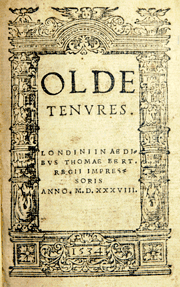
Olde Tenures. Title page of 1538
edtion printed by Thomas Berthelet
- Olde Tenures printed by Thomas Berthelet, London, 1538. This is a ninth edition and probably written in Edward III’s reign. There are brief descriptions of the various tenures and their incidents, of the various estates which a tenant might hold, of villeinage and villain tenure, of creditors’ rights in the land, and of the various kinds of rents. The book ends by defining and distinguishing suit real and suit service. Its chief claim to fame is that it suggested to Littleton the composition of his treatise. Only two other copies of this imprint in North America.
- Les Tenures du monsieur Littleton, ouesque certain cases addes per auters de puisne temps, queux cases vous troveres signes…Et cy un foits pluis admotes al request de gentill homes students le ley dentleterre by Thomas Littleton. Imprinted by Richard Tottell (or Rychard Tottill) in London, 1583. This is a valuable edition of a seminal work of English law and the first English law book to be printed, circa 1481. It contains an index and the treatise id divided into numbered sections, the scheme adopted by Coke in his great gloss on Littleton.
- A Learned commendation of the politique lawes of England: by most pitthy reasons and evident demonstrations they are plainelye proved farre to excel aswell the Civile Lawes of the Empiere [etc.] by John Fortescue. Printed by Richard Tottell, London, 1573. This is the second issuance of the first English translation of a work deemed among one of the classics of English constitutional theory and written in the late 15th century. Highly popular, it was the first work to examine extensively trial by jury and the Inns of Court.
Colonial and Early American Materials
Another special assortment of books is the early printings of colonial session laws. One of the treasures of this collection is the Charter of Pennsylvania printed by Benjamin Franklin.
- Extracts From the Votes and Proceedings of the American Continental Congress, Held at Philadelphia on the 5th of September, 1774. Containing The Bill of Rights, a List of Grievances, Occasional Resolves, the Association, an Address to the People of Great-Britain, a Memorial to the Inhabitants of the British American Colonies. Published by Order of Congress in Philadelphia and printed in Newport, Rhode Island in 1774. This rare 1774 Newport printing is the forerunner of the Declaration of Independence and includes extracts of the first Continental Congress, including the scarce Quebec address.
- The Federalist on the New Constitution, written in 1788 by Alexander Hamilton, James Madison and John Jay and published by Benjamin Warner in 1818 in Philadelphia. This is an important fifth edition of the Federalist Papers, “the most influential American political work” (Howes), and is the Philadelphia imprint with Madison’s revisions and his claims of authorship over Hamilton.
- Third edition of the Federalist Papers…to which is added, Pacificus, on the Proclamation of Neutrality, in 1793. Published in New York by Williams and Whiting, 1810, this third edition is in two volumes and housed in a custom clamshell box.
Fugitive Slave Law Act Materials
The Law Library has accumulated a rare collection of the session laws of the early republic as well as pamphlets and tracts dealing with fugitive slave laws.
- The Fugitive Slave Law and Its Victims by Samuel May. Printed in 1856 in New York by the American Anti-Slavery Society. This 48-page octavo is a first edition. The first part is a legislative history of the Fugitive Slave Law of 1850 while the second contains a compilation of atrocities the law provoked. Particular attention is given to free black who were kidnapped, transported south and sold into slavery. Only two other copies known to exist in North American law libraries. A second edition was published in 1861.
- A Report of the Decision of the Supreme Court of the United States, and the Opinions of the Judges Thereof, in the Case of Dred Scott versus John F.A. Sandford. December Term, 1856 by Benjamin C. Howard, reporter. Printed in Washington, D.C. by Cornelius Wendell, 1857. This edition is the scarcer of the report’s two first separate printings, and the one sponsored by the United States Senate, of “[t]he most controversial decision of the century and perhaps in the history of the Supreme Court.” All nine opinions of the Justices are set forth in this volume.
- Historical and Legal Examination of That Part of the Decision of the Supreme Court of the United State in the Dred Scott Case, Which Declares the Unconstitutionality of the Missouri Compromise Act…Carrying Slavery Along with It [etc.] by Thomas H. Benton. Published by D. Appleton and Company of New York in 1857. This book is a first edition of the first major, book-length critique of the Dred Scott decision, “one of the most meticulous, thoroughly documented, and closely reasoned pieces of historical research ever done on a single subject of constitutional law.”
Canon Law and Practice
The Law Library has purchased a number of early printings of works dealing with various aspects of Canon law and practice. There are around 30 titles in this specialty collection.
Continental Law
The Rare Book Room contains primary legal sources used and published in Europe. Some of these rare titles cover French and Italian law.
- Code Napoleon. Published in Paris in 1808. This is an original edition of the civil law of France enacted by Napoleon Bonaparte.
- Laws of Genoa, Statuta et Decreta Communis Genuae: Quae Quam Ordinatissime Diligentissime et Castigatissime ad Communem Cunctorum Genuensium Utilitantem nec non Voluptatem Impressa Sint Liquido Patebit Legentibus, edited by Antonio Maria Visdomini and published in 1498 in Bologna by Caligola de’ Bazalieri. This is the only edition and is printed in Latin.
- Iuris Civilis Lexicon ex Variis Probatorum Autorum Commentariis Congestum by Jakob (Jacobus) Spiegel [1483-c.1547] and printed in Strassburg, 1538. This is a first edition of an important humanistic law dictionary by Spiegel, a lawyer and privy counselor to Holy Roman Emperor Charles V, who also was a notable humanist scholar who corresponded with Erasmus. The Lexicon is a dictionary of terms in Roman law, and was issued 12 times, the first edition (in this collection) in 1538 and the final in 1577.The entries contain references to examples in the Roman juristic literature. The part comprising 54 numbered pages is Spiegel’s exegesis of sections of the Code, the Twelve Tables and other topics in Roman law with added commentary by Cristoph Hegendorf. Only two other copies exist in North America.
Pre-1600 English Printings
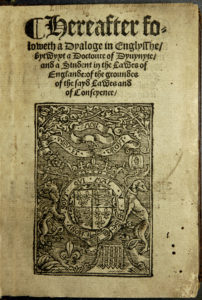
Woodcut from title page
of the first edition in English
of Doctor and Student.
Printed by Robert Wyre.
London. 1530?
- Magna Cart Cu[m] Alijs Antiquis Statutis, Q(u)orum Catalogum in Fine Operis Reperies or the Magna Carta, a scarce early printing by Thomas Berthelet of London, 1531. This is a sixth edition in Latin and Law French and a reprint, with additions, of the edition printed by Richard Pynson in 1527.
- Magna Carta. The Great Charter called in latyn Magna Carta with divers olde statutes whose titles appere in the next leafe. Newly corrected [etc.]. Printed by Thomas Petyt in London, 1542. Only this printing and those of 1534 and 1541 were in the vernacular. This edition and that of 1541 expand upon the contents of the 1534 edition and arrange the statutes chronologically.
- Magna Carta, Cum Statutisquae Antiqua Vocantur, Iam Recens Excusa, & Summa Fide Emendata, Iuxta Vetusta Exemplatia ad Partliamenti Rotulos Examinata: Quibus Accesserunt Nonnulla Nunc Primum Tuypis Edita. [And] Secunda Pars Veterum Statutorum. Printed in 1556, London, by Richard Tottel. A first edition by Tottel, the text is in Latin, English and Law French. This edition contains one of the earliest printings of the Magna Charta and includes the Charta de Foresta of Henry III, the Statutes of Merton and Marlebridge, and the Statutes of Edward I, which contain Edward’s notorious statutes regarding Jews, which condemned them for irreverence and prevented them from practicing usury or acquiring land from Christians through pledges.
- De Termino Michaelis. Anno. iii. Henrici vi. Printed circa 1528 by Richarde Pynson, printer to the King. This magnificent printing of the legal decisions during the reign of Henry VI is by Pynson, who became King Printer in 1508, and is the first English publishers of the Year Books, the law reports of the Middle Ages. After Caxton, Pynson is the most important English printer and his books are marked by clarity of types and impression.
- Dyaloge in Englysshe bytwyxt a Doctoure of Dyvynyte and a Student in the Lawes of Englande: of the groundes of the sayd Lawes and of Conscyence by Christopher St. Germain. Printed in London in 1530 by Robert Wyer. This is a first edition of the first work on English equity. Originally written in Latin in 1523, the work contains two dialogues between a doctor of divinity and a student of English law and popularized canonist learning on the nature and object of law, the religious and moral standards of law, the foundations of the common law, and other issues regarding the jurisdiction of Parliament. This very important work in the development of equity was still an authority well into the 18th century and influenced several writers such as Blackstone and Beale. (The collection also has the Newly Corrected and Imprinted with New Additions edition printed by Thomas Wright and Bonham Norton in 1598 which is an octavo.)
- Eirenarcha: or of The Office of the Justices of Peace, in two Bookes: Gathered in 1579 and now reuised, and firste published, in the 24 years of the peaceable reigne of our gratious Queene Elizabeth [etc.] by William Lambard(e). Printed in London, 1581, by Newbery and Bynnemann. This title is a first edition, of some fifteen, of the most important and influential early work on English justices of the peace, described by Holdsworth as “complete and systematic [and] clearly arranged and comprehensive.” (The collection also contains a second edition by the same printers, published in 1582.)
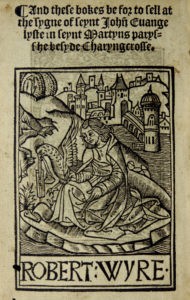
Printer’s mark of Robert
Wyre from Doctor and
Student. London. 1530?
- Englishing of the Statutes. In this volume are conteined the statutes made and established from the time of king Henry the thirde, unto the first yere of the reigne of our most gracious and victorious soveraigne lorde kyng Henry the viii. Printed in London by Henry Wykes, 1564. An uncommon edition of one of the two early renderings of the statutes of the realm into English, commencing with Magna Carta and playing a significant part in the “Englishing” of English law (long in Latin and Law French) during the Tudor reign.
- The Duties of Constables, Borsholders, Tythingmen, And Such Other Lowe and Lay Ministers of the Peace. Whereunto be Also Adioyned the Severall Offices of Church wardens. Of Distributors of the Provision for Noisome Foule and Vermin: Of the Collectors, Overseers, And Governours of the Poore: And of the Wardeins and Collectours for the Houses of Corrections. Now Enlarged by William Lambard(e) and printed by Ralfe Newberie in London, 1594. This is a third enlarged edition which was first published in 1582. Lambard, or Lambarde, was a barrister and legal historian who was the keeper of records at the Rolls Chapel and the Tower of London. (The collection also contains the fourth enlarged edition printed by Thomas Wright of London, 1599.)
- Le Court Leete et Court Baron collect per Iohn Kitchin de Greies Innee…ouesque diuers nouel additions, come Court de Marshalsey, Auncient demesne, Court de Pipowders, Essoines, Imparlance…& diuers auter matters by John Kitchin. Published by Thomas W[r]ight and Bonhami Norton, London, 1598. This is a last sixteenth centry edition of a work which, together with Lambarde’s Eirenarcha, remains essential to the understanding of Tudor local courts and government, treating of both civil and criminal matters. Volume includes Kitchin’s lengthy commentary.
- A Briefe Treatise of Testaments and Last Willes, Very Profitable to be Understoode of All the Subjects of This Realme of England, (Desirous to Know, Whether, Whereof, And how, They May Make Their Testaments: And by What Meanes the Same May be Effected or Hindered,) And no Lesse Delightfull, Aswell for the Rareness of the Wroke, As for the Easines of the Stile, And Method: Compiled of such Lawes Ecclesiasticall and Civill, As be not Repugnant to the Lawes, Customes, Or Statutes of this Realme, Nor Derogatorie to the Prerogative Royall… by Henry Swinburne [1560?-1623]. Printed by John Windet, 1590, London. This is a first edition of the first standard treatise on wills. From the 16th until well into the 17th century Swinburne’s was the standard treatise on the law as it pertained to wills and executors as administered in the ecclesiastical courts.
- Anno XXIIII, Henrici VIII. Actis made in the Session of this present parliament, holden upon prorogation at Westmynster…in the xxiii yere of the reign of…Kynge Henry the VIII [1533] [etc.]. Published by Thomas Berthelet, London, 1546. This book is about the Parliament in which the first great step was taken to extinguish papal jurisdiction and power in England, ensuring that Henry’s divorce would be determined by Cranmer’s archiepiscopal court, and leading to Henry’s supremacy in the English Church.
- Henry the Eyght by the Grace of God Kynge of Englande…beganne this thirde Session of his…parliament at Westminster, the XIIII daye of Januarye, in the fiue and thirty yere of his…reigne [1544] [etc.]. Printed by Thomas Marsh, London, around 1575. This rare, last early issuance of Henry VIII’s penultimate Parliament, establishing the succession to the throne of Mary and then Elizabeth and clarifying and expanding the power of the jury, particularly in cases of foreign treason. Four known copies in existence.
- Les Commentaries, Ou Reportes…de diuers cases esteant matters en ley, & de les Arguments sur yceux [etc.][bound with] La Second Part de les Reports, ou, Commentaries[etc.] by Edmund Plowden. Published by Thomas W[r]ight, London, 1599, part I, and by Carol Yetsweirt in 1594 for part II. These two parts are the last 16th century editions of both parts of Plowden’s Commentaries, the reports marking the break with the Year Books and providing, according to Dr. Baker, “the conception of a law report as a reasoned exposition of the law, with learned gloss.”
Use of materials in the Archives is by appointment only. Contact Frederick Chan at (314) 935-6415 or by e-mail.